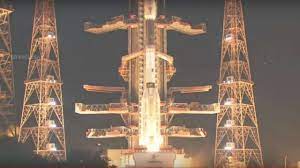GSLV-F10 Launch And EOS-03 Satellite:

The launch of earth observation satellite EOS-03 onboard GSLV-F10 was unsuccessful recently because of an anomaly in the rocket’s cryogenic upper stage.
- GSLV-F10 was ISRO’s eighth flight with indigenous cryo, 14th GSLV flight and 79th launch from Sriharikota.
- EOS-3 was the first state-of-art agile Earth Observation Satellite which would have been placed in a geo-synchronous orbit around the Earth.
- It was expected to provide near real-time imaging, which could be used for quick monitoring of natural disasters, episodic events and any short-term events.
- The mission life of the satellite was 10 years.
- The GSLV is geosynchronous satellite launch vehicle.
- The GSLV Mark II is the largest launch vehicle built by India.
- As its name suggests, it can launch satellites that will travel in orbits that are synchronous with the Earth’s orbit.
- These satellites can weigh up to 2,500 kg and are first launched into transfer orbits that have a distance from Earth of 170 km at closest approach and about 35,975 km at furthest approach which is close to the height of the geosynchronous orbit.




